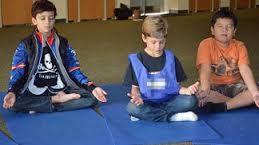Religion
Why Encinitas Public School Yoga Promotes "Religion"
Explaining problems with the public school yoga trial decision
Posted July 10, 2013
In reading comments on my previous blog post, and similar online discussions, it appears that many people assume that the Encinitas school yoga program was upheld in a recent trial decision because the school yoga program--like American yoga generally--was taught devoid of "religious" content. This is not the case.
Let me first address the assumption that American yoga is free from religion. According to Pew Research Center surveys, 28% of religiously unaffiliated Americans (and 23% of the total population) "believe in" yoga as a "spiritual practice." The Yoga Journal reports that 32% of practitioners were motivated to start yoga by a desire for "spiritual development," and 30% are motivated to keep practicing in order to continue developing spiritually. 51% of practitioners say that knowledge of yoga terminology is a "must have" in a yoga instructor. Anton Drake, author of Atheist Yoga, acknowledges that mystical ideas, for instance religious beliefs about chakras, are "definitely part of yoga's popular image" and can affect people's "concepts of spirituality without their being totally aware of it." (You can find a lengthy discussion between Drake and myself on his website). Sociological research indicates that as people practice yoga for longer periods of time, they are increasingly likely to internalize yoga's religious philosophy.
EUSD did not implement just any yoga program. The terms of a $533,720 grant from the Jois Foundation obligated EUSD to promote Ashtanga yoga. Ashtanga (eight-limbed) yoga was developed by Krishna Pattabhi Jois from the Yoga Sutras, a sacred text for Hindus. The eight limbs of Ashtanga are 1) yama: moral restraint, 2) niyama: ethical observance; 3) asana: posture; 4) pranayama: focused breathing; 5) pratyahara: calm mind; 6) dharana: attention; 7) dhayana: meditation; 8) samadhi: union with God. Ashtanga emphasizes postures and breathing, on the premise that these practices will automatically lead practitioners to experience the other limbs--including union with the Universal (Brahman)--"whether they want it or not."
Whereas Protestant Christianity focuses on words and beliefs, Ashtanga yoga's focus is practice and experience. Ashtanga is nevertheless "religious": it explains ultimate problems and connects individuals with suprahuman energies, beings, or transcendent realities (worldview, or big picture of reality); and cultivates spiritual awareness or virtues of ethical and moral character (ethos, or philosophy of how to live).
Jois insisted that every yoga session begin and end the same way--with Sun Salutations (Surya Namaskara) and lotuses, coordinated with focused breathing (to "let the prana [vital breath] flow"). These are deeply symbolic rituals that express and instill religion through repetition. Jois prescribed Surya Namaskara to "pray to the sun god," Surya, chief Hindu solar deity. With "praying hands" (anjalimudra), one reaches to the sun in praise and petition, bows in surrender and worship, and rises up remembering the true "Sun" within. Sitting in lotus symbolizes spiritual purity and enlightenment and presumably moves prana to bring about meditation and Samadhi.

Meditating in lotus pose in public school yoga program
The Jois Foundation (founded "in loving dedication" to K.P. Jois), with funding from billionaire Paul Tudor Jones whose wife Sonia is an Ashtanga devotee, gave EUSD a half million dollar grant to implement a comprehensive "Ashtanga yoga" curriculum. The grant required that the Jois Foundation "train" and "certify" EUSD yoga instructors, shape the EUSD curriculum, and keep rights to export the curriculum to other schools once a "research study" reported benefits.
Although EUSD spokespersons testified to ignoring the grant's terms, "EUSD yoga" classes opened with Sun Salutations and finished with lotuses (the postures are still called "lotuses," not "criss-cross applesauce" in the printed curriculum and in a current EUSD promotional video), coordinated postures with focused breathing, and used yamas and niyamas to teach moral character. In fact, it came to light just after the trial's conclusion that two EUSD-employed "Jois Foundation teachers" apparently took EUSD students on a "field trip" in March 2013 to demonstrate "teaching Ashtanga yoga to children both in and out of the school system" at an overtly religious Ashtanga conference (opened by a Ganesh Puja) in San Diego!
After children and parents began complaining that the EUSD program seemed religious, administrators changed wording and tweaked pose sequences. Teachers removed posters of an eight-limbed Ashtanga tree and sequences taught by "K. Pattabhi Jois Ashtanga Yoga Institute," and stopped teaching children to color mandalas (sacred symbols for visual meditation). Teachers stopped using Sanskrit--except the word "yoga," a Sanskrit term for "yoking" with the divine. Kids still used Sanskrit (a "sacred" language for Hindus), greeting teachers with Namaste ("I bow to the god within you") and calling the final "resting" pose shavasana ("corpse"--symbolic encouragement to reflect on one's death to inspire virtuous living). Kids still chanted Om (symbolizing Brahman) as teachers sounded bells (used in sound meditation) and verbally guided meditations to transition between lotuses and into "resting." Teachers continued using symbolic gestures such as "praying hands" (anjalimudra) and "wisdom gesture" (jnanamudra), which in Ashtanga yoga symbolize union with the divine and instill religious feelings.
Despite EUSD officials' claim to have removed even the appearance of religion from the curriculum, more than "stretching" and "breathing" continued to take place in EUSD classrooms. Children recognized what was going on as religious, which is why, for instance, many of them chanted Om without needing prompting. Yoga practice extended beyond the P.E. classroom--for example as a tool for "calming" children during all-school assemblies--so even children who opted out of P.E. for religious reasons could not opt out of the comprehensive yoga curriculum.
Psychology research, on "extinction and relearning," shows that once a person learns an association (e.g. a religious association of a yoga pose), the memory of that association doesn't go away, regardless of whether one tries to replace it with new associations (e.g. by associating the same yoga pose with "secular" notions of "health and wellness"). Even if the old association is temporarily suppressed, it doesn't disappear entirely. It's still there and can be reactivated, or relearned, very quickly. Retrieval cues (such as familiar yoga postures) bring former associations to mind. This is actually how advertisements work--by creating associations that you can't forget even if you try (complete this musical phrase: 8-6-7--5-3-0 __ . . .). There's another psychological process, of "transitive inference," at play here as well. Public-school children who reason "yoga = postures = feeling good," may equate yoga with feeling good, and be more inclined to seek out yoga, regardless of whether the context is "secular" or "religious."
Suppose that someone claims that making the sign of the cross gesture is a physical exercise that strengthens the arm muscles and helps to limber up the hand for writing--and insists that, for me, the exercise has no religious meaning whatsoever. Other people are still going to interpret the sign of the cross as a religious gesture. And if you teach a "secularized" sign-of-the-cross "exercise" in public schools to prepare for writing, the exercise is still going to function as an advertisement for the religious version of the practice because so many people associate the gesture with religious meanings.
Regardless of whether Jois or EUSD intended for yoga to affect children's religious beliefs, sociological research suggests that people who begin practicing yoga for its physical benefits gradually come to adopt yoga philosophy, causing them to change their religious worldviews.
Kristin is a college student who grew up Catholic and tried yoga thinking it was "not religious. I mean they have yoga classes at the YMCA and that's a Christian organization." Kristin explored yoga "starting with the physical aspects," since she enjoyed the stretching. But she says, "then I started reading" and discovered a "really good mind body spirit thing." Kristin now considers the "eight limbs of Ashtanga" to be "basically similar to the 10 commandments," but better since the principles are "just like suggestions" by contrast with rule-oriented Christianity.
EUSD used funds from a religious organization with a missionary agenda to implement a religious yoga curriculum that furthers the goals of the funding foundation. U.S. and California Constitutions prohibit this kind of complicity of government and religion.




